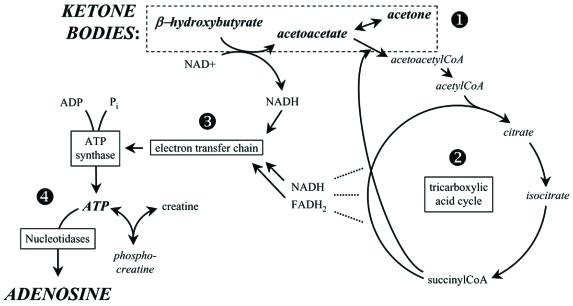Fig. (1).
The metabolic relationship between ketones and adenosine. Compounds upregulated by a ketogenic diet or exogenous ketones are italicized. (1) During ketolytic metabolism, the ketone bodies β-hydroxybutyrate (and its breakdown products acetone and acetoacetate) are either generated locally or hepatically and transported via the blood to other tissues (such as brain). Ketones are converted intracellularly into acetyl-CoA which enters the tricarboxylic acid cycle. (2) This mitochondrial energy cycle generates, at multiple steps (----), protons and electrons that are channeled to the electron transport chain by NADH and FADH2 (β-hydroxybutyrate conversion to acetoacetate also contributes). Many steps of the tricarboxylic acid cycle are omitted for simplicity. (3) The electron transport chain drives an electrochemical gradient across the mitochondrial outer membrane and ultimately oxidative phosphorylation which forms ATP from ADP and phosphate (Pi) by ATP synthase. (4) Enhanced ATP can be converted to phosphocreatine for energy storage, or broken down to its core molecule, adenosine. Adenosine levels inside and outside of the cell membrane are influenced concurrently by an equilibrative transporter. Due to the very large ATP / adenosine ratio inside the cell, a small increase in intracellular ATP could translate into a large relative increase in intracellular, and thus extracellular, adenosine.

